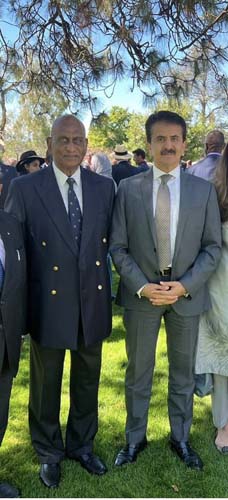
Zahid Hafeez Chaudhri meets Brigadier-General John Jacob’s great-great-grandson
Newswire
Canberra: Pakistani High Commissioner to Australia Zahid Hafeez Chaudhri this week met Dr Elmo Jacob, great-great-grandson of Brigadier-General John Jacob, famously known as John Jacob of Jacobabad.
“Glad to meet Dr Elmo Jacob, great-great-grandson of Brigadier-General John Jacob, famously known as John Jacob of Jacobabad,” he tweeted.
The envoy added: “Jacobabad, a vibrant city in Sindh, Pakistan was founded by Gen Jacob and is named after him.”
Brigadier-General John Jacob who died in 1858, was an officer of the British East India Company who served in colonial India for the major portion of his career.
He is known for the cavalry regiment called 36th Jacob’s Horse, and for founding the town of Jacobabad, in modern day Pakistan, where he planned and supervised the transformation of thousands of acres of desert into arable land over the course of twenty years.
The scale of progress and prosperity his works brought to the region can be appreciated by comparing those regions’ relative prosperity compared to areas which were not under his administrative jurisdiction.
He was born at Woolavington, in the county of Somerset, England, where his father the Reverend Stephen Long Jacob was incumbent.
His mother was Susanna, daughter of the Reverend James Bond of Ashford, Kent, England. He was schooled by his father until he obtained his cadetship to Addiscombe Military Seminary. A number of the young cadets there who were his contemporaries, included such famous officers as Eldred Pottinger, Robert Cornelis Napier, Henry Mortimer Durand, Vincent Eyre and others.
He was commissioned into the Bombay Artillery (Bombay Army) on his 16th birthday, and subsequently sailed for India in January 1828, never to set foot in England again.
In 1847 Jacob was placed in political charge of the frontier and established his headquarters at Khangurh. At the time he set foot on there, the area was known as Upper Sind ‘desert’, littered with marauders who looted for living.
At the first place he restored peace in the area by thoroughly defeating the predator tribes. Then he started building infrastructure for the town, (at the village of Khangurh and its surroundings).
Being an architect and an engineer himself, he designed and then executed the plans of laying a wide road network around the town that measured a good 600 miles.
His biggest and most important feat was the excavation of Begaree Canal, originating from Guddu barrage on river Indus, going round the district irrigating thousands of acres of land previously uncultivated, thereby providing means of living to thousands of people.
